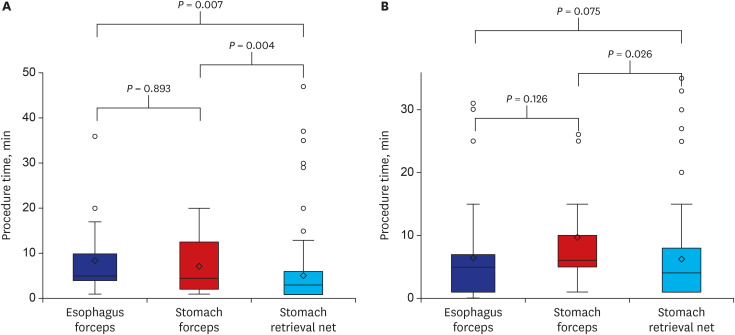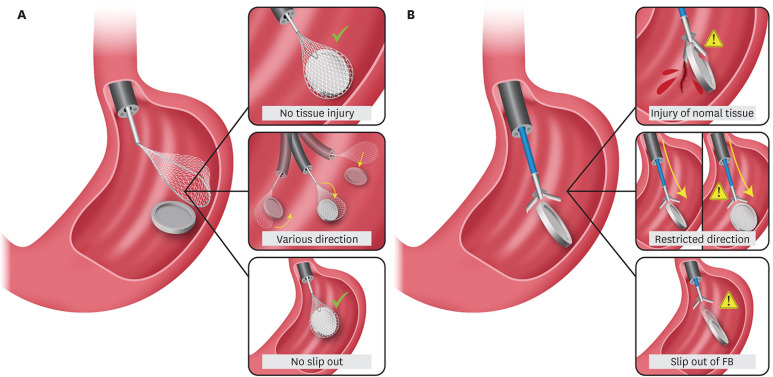J Korean Med Sci.
2023 Jan;38(1):e2. 10.3346/jkms.2023.38.e2.
Clinical Experiences and Selection of Accessory Devices for Pediatric Endoscopic Foreign Body Removal: A Retrospective Multicenter Study in Korea
- Affiliations
-
- 1Department of Pediatrics, Pusan National University Children’s Hospital, Pusan National University College of Medicine, Yangsan, Korea
- 2Department of Pediatrics, Chungbuk National University College of Medicine, Cheongju, Korea
- 3Department of Pediatrics, Gangneung Asan Hospital, University of Ulsan College of Medicine, Gangneung, Korea
- 4Department of Pediatrics, Gyeongsang National University School of Medicine, Gyeongsang Institute of Sciences, Gyeongsang National University Hospital, Jinju, Korea
- 5Department of Occupational and Environmental Medicine, Seoul St. Mary’s Hospital, College of Medicine, The Catholic University of Korea, Seoul, Korea
- 6Division of Gastrointestinal Surgery, Department of Surgery, Pusan National University Yangsan Hospital, Yangsan, Korea
- KMID: 2537446
- DOI: http://doi.org/10.3346/jkms.2023.38.e2
Abstract
- Background
Swallowing of foreign bodies (FBs) is the most common indication of therapeutic endoscopy in children. Endoscopic removal may be necessary depending on the type of FB, age of the child, and location of the FB. We attempted to analyze the characteristics of each device used for the endoscopic removal of FBs in children.
Methods
Medical records of the patient’s age, sex, weight, type, location, size, shape, type of device used for endoscopic removal, and endoscopic time were retrospectively collected.
Results
A total of 424 FB removal procedures were analyzed. The average age of the patients at the time of FB removal was 4.1 ± 3.7 years. Coins were the most common FBs (192, 45.3%). The most common locations of the FBs were the esophagus (45.7%) and the stomach (48.3%), respectively. For a total of 371 cases, forceps were used in 96 cases (25.9%) for esophageal FBs and in 25 cases for gastric FBs (6.7%), while nets were used in 250 cases (67.4%) for gastric FBs retrieval; the average durations of the procedures were 7.2 ± 7.4 minutes, 8.5 ± 7.2 minutes, and 5.7 ± 7.3 minutes, respectively (P = 0.003). The procedure time was significantly shorter, in the group of patients with low body weights, when nets were used than when forceps were used to remove gastric FBs (P = 0.001).
Conclusion
The endoscopic procedure duration, in low-weight children, was shorter when retrieval nets were used than that with forceps.
Keyword
Figure
Reference
-
1. Chen X, Milkovich S, Stool D, van As AB, Reilly J, Rider G. Pediatric coin ingestion and aspiration. Int J Pediatr Otorhinolaryngol. 2006; 70(2):325–329. PMID: 16157391.2. Balekuduru AB, Shetty B, Dutta A, Subbaraj SB. Profile of foreign body ingestion and outcomes of endoscopic management in pediatric population. J Dig Endosc. 2017; 8(1):17–23.3. Kay M, Wyllie R. Foreign body ingestions in the pediatric population and techniques of endoscopic removal. Tech Gastrointest Endosc. 2013; 15(1):9–17.4. Sugawa C, Ono H, Taleb M, Lucas CE. Endoscopic management of foreign bodies in the upper gastrointestinal tract: a review. World J Gastrointest Endosc. 2014; 6(10):475–481. PMID: 25324918.5. Lee JH. Foreign body ingestion in children. Clin Endosc. 2018; 51(2):129–136. PMID: 29618175.6. Jayachandra S, Eslick GD. A systematic review of paediatric foreign body ingestion: presentation, complications, and management. Int J Pediatr Otorhinolaryngol. 2013; 77(3):311–317. PMID: 23261258.7. Khorana J, Tantivit Y, Phiuphong C, Pattapong S, Siripan S. Foreign body ingestion in pediatrics: distribution, management and complications. Medicina (Kaunas). 2019; 55(10):686. PMID: 31615117.8. Lin CH, Chen AC, Tsai JD, Wei SH, Hsueh KC, Lin WC. Endoscopic removal of foreign bodies in children. Kaohsiung J Med Sci. 2007; 23(9):447–452. PMID: 17766213.9. Lim CW, Park MH, Do HJ, Yeom JS, Park JS, Park ES, et al. Factors associated with removal of impactted fishbone in children, suspected ingestion. Pediatr Gastroenterol Hepatol Nutr. 2016; 19(3):168–174. PMID: 27738598.10. Ryoo E, Kim KM, Kim KM. Scientific Committee of the Korean Society of Pediatric Gastroenterology, Hepatology, and Nutrition. Pediatric endoscopic sedation in Korea: a survey of the Korean Society of Pediatric Gastroenterology, Hepatology, and Nutrition. Korean J Pediatr Gastroenterol Nutr. 2008; 11(1):21–27.11. Wyllie R. Foreign bodies in the gastrointestinal tract. Curr Opin Pediatr. 2006; 18(5):563–564. PMID: 16969173.12. Vicari JJ, Johanson JF, Frakes JT. Outcomes of acute esophageal food impaction: success of the push technique. Gastrointest Endosc. 2001; 53(2):178–181. PMID: 11174288.13. Kramer RE, Lerner DG, Lin T, Manfredi M, Shah M, Stephen TC, et al. Management of ingested foreign bodies in children: a clinical report of the NASPGHAN Endoscopy Committee. J Pediatr Gastroenterol Nutr. 2015; 60(4):562–574. PMID: 25611037.14. Balekuduru AB, Shetty B, Dutta A, Subbaraj SB. Profile of foreign body ingestion and outcomes of endoscopic management in pediatric population. J Dig Endosc. 2017; 8(1):17–23.
- Full Text Links
- Actions
-
Cited
- CITED
-
- Close
- Share
- Similar articles
-
- Upper Gastrointestinal Tract Foreign Bodies
- Accessory Devices Frequently Used for Endoscopic Submucosal Dissection
- Removal of Rectal Foreign Bodies Using Tenaculum Forceps Under Endoscopic Assistance
- Clinical Analysis of Foreign Bodies in Gastrointestinal Tract in Children
- Endoscopic Removal of a Pork Bone from the Sigmoid Colon in a Patient with Ulcerative Colitis



